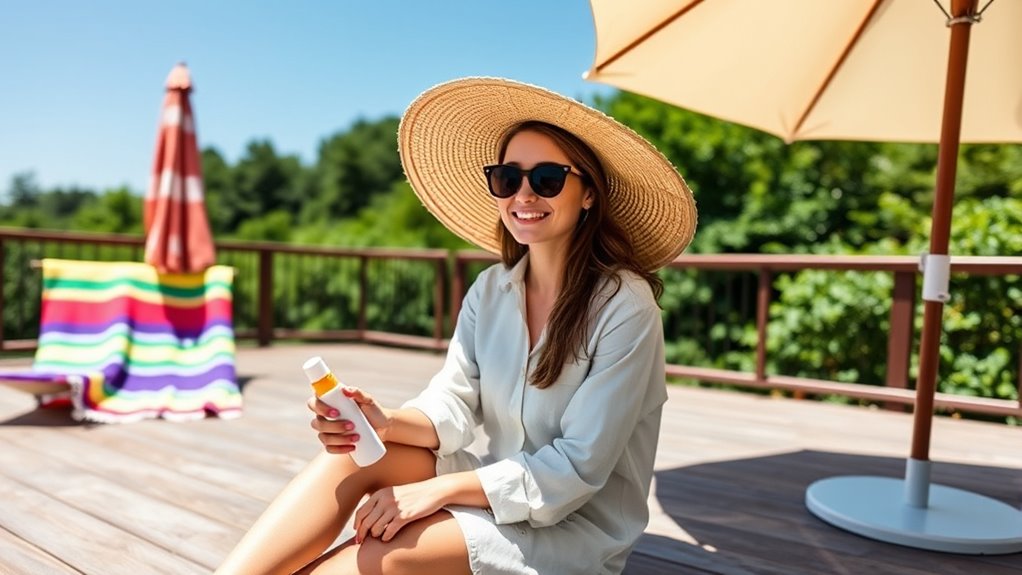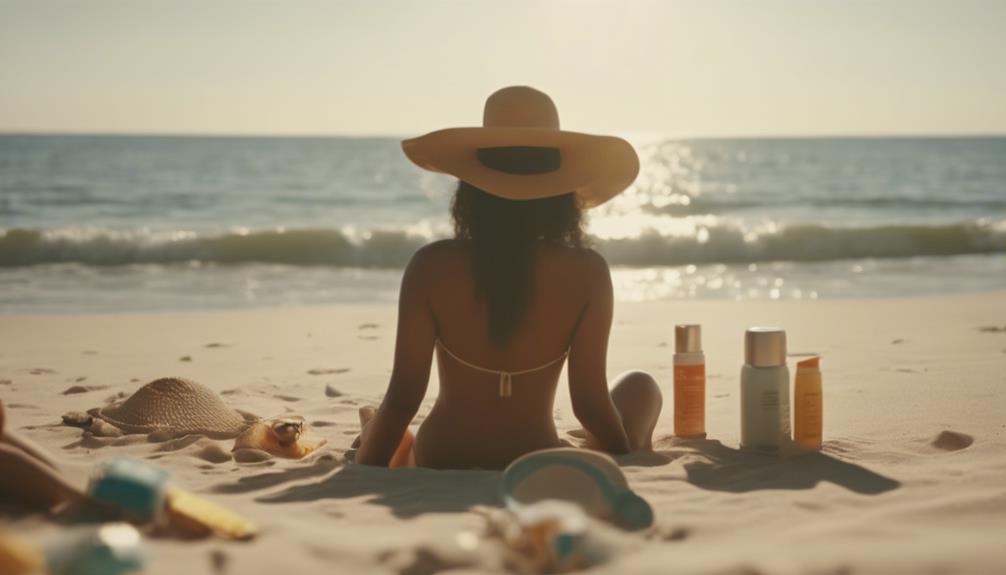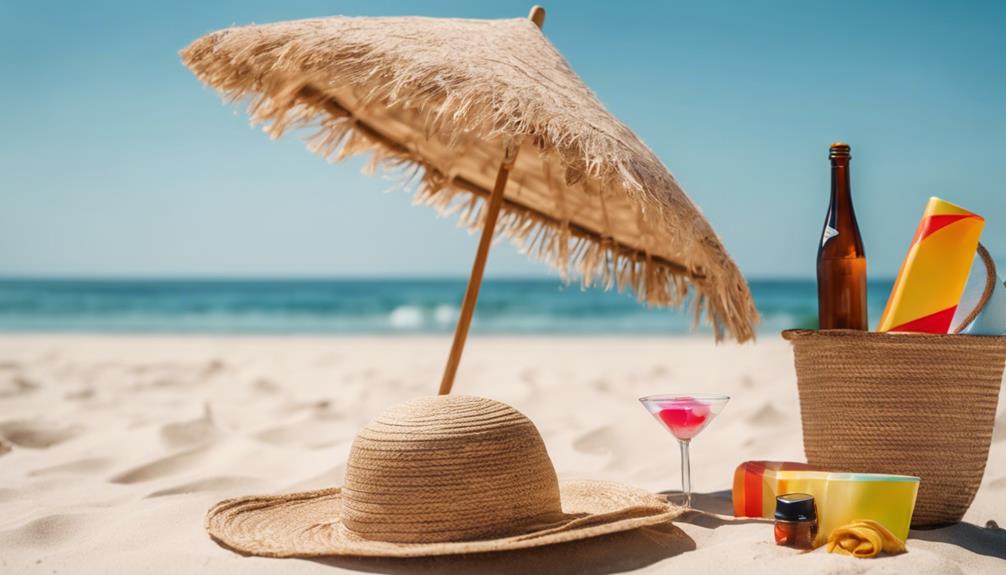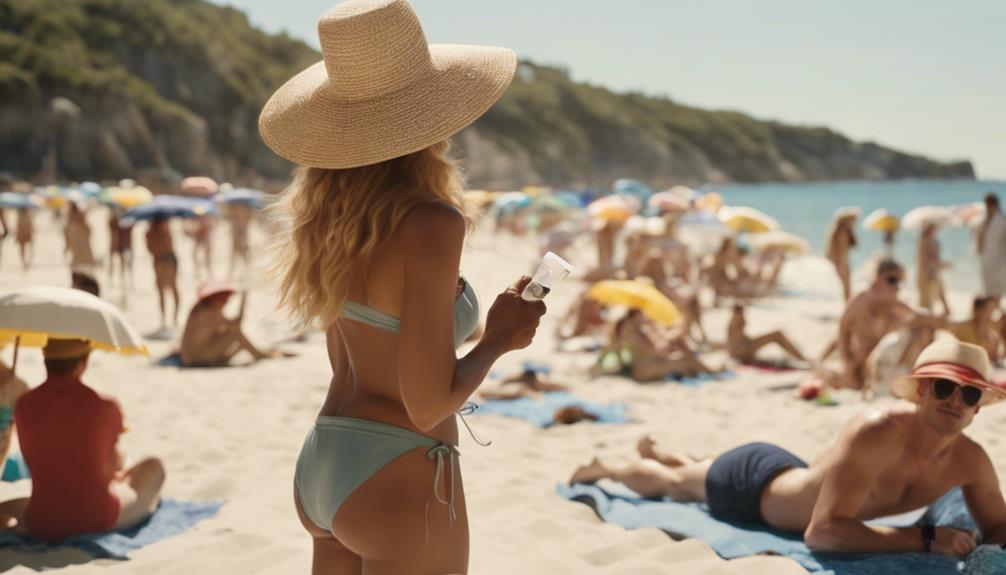To tan safely, use broad-spectrum sunscreen with SPF 30+ and apply it 15-30 minutes before sun exposure, reapplying every two hours. Schedule outdoor activities outside peak hours (10 a.m. to 4 p.m.) and seek shade when possible. Wear protective clothing, wide-brim hats, and UV sunglasses, and incorporate safer tanning options like self-tanners or spray tans. Monitoring your skin for early signs of damage helps prevent long-term issues—learn more to protect your skin effectively.
Key Takeaways
- Use broad-spectrum sunscreen SPF 30+ 30 minutes before sun exposure and reapply every two hours.
- Schedule outdoor activities before 10 a.m. or after 4 p.m. to avoid peak UV rays.
- Wear protective clothing, wide-brim hats, and UV-protective sunglasses during sun exposure.
- Seek shade and avoid reflective surfaces like water, sand, and snow during peak hours.
- Consider safer tanning alternatives like self-tanners or spray tans instead of prolonged sun exposure.
Proper Sunscreen Usage for Effective Protection

To guarantee your sunscreen provides maximum protection, it’s essential to apply it correctly and consistently. Start with about one ounce—enough to cover your entire body—and use a teaspoon for your face. Shake the bottle well and rub it thoroughly into your skin, ensuring even coverage. Don’t forget often-missed spots like ears, neck, and the tops of your feet. Apply sunscreen at least 15 to 30 minutes before heading outside to let it bind properly. Reapply every two hours, especially after swimming, sweating, or towel drying. Use water-resistant formulas if you’ll be in water or active outdoors. Physical sunscreens with zinc oxide or titanium dioxide are great for sensitive skin. Remember, expired sunscreen loses effectiveness, so check the date regularly. Proper application is key to effective sun protection. Additionally, choosing sunscreens formulated with broad-spectrum protection can help shield your skin from both UVA and UVB rays. Incorporating AI-driven skin analysis can assist in selecting the most suitable products for your skin type and conditions. Regularly reassessing your sun protection routine ensures ongoing effectiveness and safety. Staying informed about sun safety tips can further enhance your skin’s protection and health. Using products with proven Glycolic Acid benefits can also improve your skin’s resilience and overall appearance, making your sun protection efforts more effective.
Best Timing and Scheduling for Safe Sun Exposure

Scheduling your outdoor activities carefully can considerably reduce your risk of skin damage from UV rays. Aim to be outdoors before 10 a.m. or after 4 p.m. when UV rays are weaker. During peak hours, from 10 a.m. to 4 p.m., UV exposure is strongest, increasing your risk of skin damage and cancer. Check the UV index daily and plan activities accordingly to stay safe. At higher altitudes, UV rays are more intense, so take extra precautions. If possible, plan outdoor outings in late evening or early morning to enjoy the sun safely. Always look for shade and avoid reflective surfaces like water, snow, and sand, which amplify UV exposure. Proper timing helps you tan safely while minimizing skin damage. Incorporating essential oils for sun protection, such as lavender or eucalyptus, into your skincare routine can also offer additional soothing and protective benefits. Additionally, using appropriate clothing and accessories can provide an extra layer of defense against harmful rays. Being mindful of UV reflection from surfaces like water and snow further enhances your sun safety efforts. For example, bioluminescent fungi exploration during nighttime can be a safe and enchanting activity that avoids peak UV exposure. Remember that historical farmhouses often have shaded areas like porches and trees that provide natural protection from direct sunlight, making them great spots to rest and avoid peak exposure times.
Essential Protective Gear to Shield Your Skin and Eyes

Wearing the right protective gear is essential for shielding your skin and eyes from harmful UV rays during outdoor activities. Opt for UPF 50+ clothing, which blocks 98% of UVA and UVB rays, and choose lightweight, breathable fabrics for comfort. Dark-colored fabrics like denim can also offer high UV protection. A wide-brimmed hat made of tightly woven material provides shade for your face, neck, and shoulders, protecting often-overlooked areas. Complement this with UV-filtering sunglasses featuring wraparound frames for full eye coverage, reducing glare and preventing UV damage. Consider accessories like umbrellas or lip balms with SPF for added protection. Always select products with high UPF ratings and reputable seals to ensure maximum defense against the sun’s rays while maintaining comfort during your outdoor adventures. Incorporating sound design techniques such as ambient sounds and subtle audio cues can enhance awareness and relaxation during outdoor activities, promoting a more mindful experience. Additionally, understanding the importance of Gold IRA Rollovers can help diversify your investment portfolio for long-term financial security, especially in uncertain economic climates. Remember that choosing protective gear with high UPF ratings is crucial to ensuring optimal sun safety. To maximize your sun protection strategy, consider how diversifying investments can contribute to your overall financial stability in unpredictable environments.
Dietary Habits That Support Healthy Tanning

Adopting specific dietary habits can markedly enhance your natural tanning process and protect your skin from UV damage. Focus on eating carotenoid-rich fruits and vegetables like carrots, tomatoes, peaches, and mangoes. These boost melanin production and improve your skin’s response to sunlight, while their high water content helps keep your skin hydrated. Incorporate protein sources such as dairy, eggs, red meats, and seafood like oysters, which provide amino acids and zinc essential for melanin synthesis and skin protection. Consume antioxidants like vitamin E, selenium, copper, and polyphenols found in berries, nuts, and seeds to neutralize free radicals caused by UV exposure. Additionally, incorporating essential minerals like zinc and magnesium from various foods can further support your skin’s resilience against sun damage. Including foods rich in antioxidants and anti-inflammatory compounds can help reduce skin inflammation caused by UV exposure and support your overall skin health. To further bolster your skin’s defenses, consider integrating vitamin-rich foods that support cellular repair and regeneration, which are crucial during sun exposure. Finally, incorporating omega-3 fatty acids from oily fish and plant oils to support skin barrier health and reduce inflammation, promoting a healthier, longer-lasting tan. Additionally, choosing Vetted electric bike conversion kits can encourage outdoor activity, enhancing your overall skin health and tanning experience. Being mindful of toilet cleaner effectiveness and proper disposal practices can also help maintain a clean and hygienic environment that supports overall well-being.
Safer Alternatives to Direct Sun Tanning

To achieve a beautiful tan without risking skin damage from prolonged sun exposure, consider safer alternatives that deliver natural-looking color quickly and conveniently. Self-tanning products, like DHA-based lotions and mousses, offer streak-free, customizable tans without UV exposure. They dry fast and often include moisturizers to prevent dryness, but require reapplication every few days as skin exfoliates. Professional spray tans provide even coverage and immediate results, lasting up to ten days with proper prep and post-tan care. Bronzing cosmetics, such as tinted moisturizers, drops, and powders, give instant color with no skin interaction, making them perfect for events or quick touch-ups. Gradual tanning lotions build subtle color gradually, reducing streaks and improving ease of use. These options help you achieve a sun-kissed glow safely and effortlessly.
Recognizing and Monitoring Skin Changes

Recognizing and monitoring skin changes is essential for catching early signs of sun damage and preventing more serious issues later on. Using skin monitoring devices, like UV radiation trackers and smartphone cameras, helps you track exposure and spot changes over time. Regular self-examinations with apps and digital tools make it easier to detect issues such as solar lentigines, erythema, deep wrinkles, uneven pigmentation, or visible capillary telangiectasias. Staying vigilant allows you to notice harmful effects of chronic sun exposure and UV sensitivity, especially if you have conditions like XP. Incorporate familiarization phases when using monitoring devices to reduce reactivity and improve accuracy. Early detection through consistent monitoring empowers you to take timely action, safeguarding your skin’s health and preventing more serious damage or skin cancer later on.
Tips for Maintaining Skin Health During Sun Exposure

Maintaining skin health during sun exposure requires a combination of protective strategies and mindful habits. Start by applying broad-spectrum sunscreen with SPF 30 or higher to all exposed skin at least 30 minutes before going outside. Reapply every two hours, especially after swimming or sweating, and choose water-resistant formulas for active days. Wear protective clothing like long sleeves, wide-brim hats, and UV-protective sunglasses to block rays physically. Seek shade during peak hours between 10 a.m. and 4 p.m., and limit your time in direct sunlight. Incorporating shade during peak hours can significantly reduce your risk of sun damage while still enjoying outdoor activities. Stay hydrated by drinking plenty of water, and use moisturizers or facial mists to replenish lost moisture. After sun exposure, soothe your skin with gentle products like aloe vera to support recovery and prevent dryness or irritation. Remember that sun protection is essential not only for preventing immediate discomfort but also for safeguarding your skin’s long-term health. Additionally, understanding Self Watering Plant Pots can inspire you to take care of your indoor environment and promote healthier plant growth.
Frequently Asked Questions
How Does Skin Type Influence Safe Tanning Practices?
Your skin type greatly influences how you should approach tanning safely. If you have fair skin (Types I and II), you’re more prone to burns and UV damage, so you should avoid prolonged sun exposure, use high-SPF sunscreen, and seek shade. With darker skin (Types V and VI), you may tolerate longer sun exposure but still need protection, as UV damage can accumulate over time. Always monitor your skin and avoid burning to reduce risks.
Can Certain Medications Increase Sun Sensitivity During Tanning?
Think of your skin as a sponge that soaks up sunlight more easily when you’re on certain medications. Yes, some drugs like antibiotics, antifungals, NSAIDs, and isotretinoin can turn up your sun sensitivity dial, making tanning risky. When you’re on these meds, you’re more prone to severe sunburns, rashes, and UV damage. Always check with your doctor, and remember to shield your skin with sunscreen and protective clothing during sun exposure.
What Are the Long-Term Skin Risks of Tanning?
Tanning long-term risks include premature aging, such as wrinkles and brown spots, caused by UV damage. It also markedly raises your chances of developing skin cancers like basal cell carcinoma, squamous cell carcinoma, and melanoma. The damage accumulates over time, leading to loss of skin elasticity and increased mutation risks. Plus, tanning can harm your eyes and trigger skin reactions, making it a risky choice for your health in the long run.
How Can I Protect My Skin From UV Damage While Tanning Indoors?
Think of your skin as a delicate canvas that UV rays can fade over time. To protect it while tanning indoors, always wear protective eyewear with 100% UV protection and follow the salon’s instructions. Limit your sessions to reduce cumulative damage, and consider sunless tanning options as a safer alternative. Remember, even controlled UV exposure isn’t risk-free—so prioritize your skin’s health above all.
Are There Natural Remedies to Enhance Tanning Without Sun Exposure?
You’re wondering if natural remedies can give you a tan-like glow without sun exposure. You can try eating carotenoid-rich foods like carrots and sweet potatoes, which can boost your skin’s natural pigmentation over time. Applying topical ingredients like tomato pulp or saffron can brighten your skin, while exfoliating with honey or rice flour reveals a fresher, glowing complexion. Hydrating agents like aloe vera and yogurt also improve skin brightness, mimicking a healthy, sun-kissed look.
Conclusion
By following these sun protection tips, you can enjoy tanning safely without risking skin damage. Remember, you might think avoiding the sun means missing out on that perfect glow, but protecting your skin now prevents long-term harm like wrinkles or skin cancer. With the right precautions, you can achieve a healthy, radiant tan while keeping your skin safe. So, don’t skip protection—your skin will thank you for it in the years to come.









